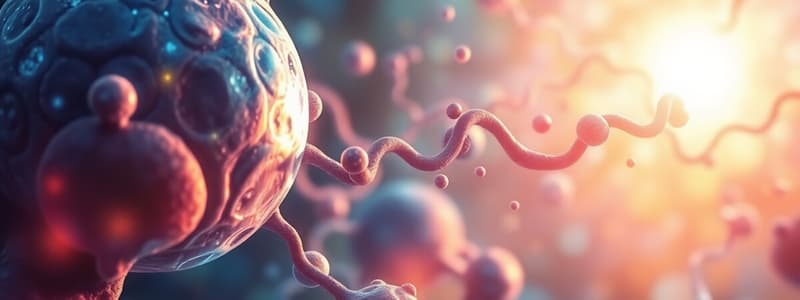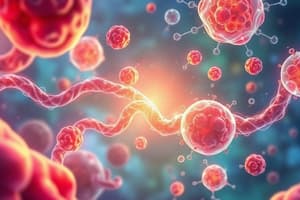Podcast
Questions and Answers
What happens to a molecule when it loses electrons?
What happens to a molecule when it loses electrons?
- It becomes reduced
- It forms a new chemical bond
- It generates a negatively-charged ion
- It becomes oxidized (correct)
Which of the following statements is true regarding oxidation and reduction?
Which of the following statements is true regarding oxidation and reduction?
- Reduction is the breaking of a chemical bond
- Oxidation generates a positively-charged ion (correct)
- Oxidation always involves gaining electrons
- Reduction results in a positively-charged ion
In the process of cellular respiration, what is the ultimate fate of energy-poor electrons?
In the process of cellular respiration, what is the ultimate fate of energy-poor electrons?
- They are stored as fats
- They are given to oxygen (correct)
- They are given to carbon dioxide
- They are converted into glucose
What is the first step of glycolysis in converting glucose into ATP?
What is the first step of glycolysis in converting glucose into ATP?
Which statement correctly describes the roles of NAD+ and NADH in oxidation and reduction?
Which statement correctly describes the roles of NAD+ and NADH in oxidation and reduction?
What is the primary reason humans need to eat?
What is the primary reason humans need to eat?
What role do chemical bonds play in metabolism?
What role do chemical bonds play in metabolism?
What is a defining feature of ATP that makes it effective for energy storage?
What is a defining feature of ATP that makes it effective for energy storage?
What happens during catabolic reactions?
What happens during catabolic reactions?
During which process is a proton gradient built across the inner mitochondrial membrane?
During which process is a proton gradient built across the inner mitochondrial membrane?
In cellular respiration, what is the function of electron carriers?
In cellular respiration, what is the function of electron carriers?
What is formed during alcohol fermentation?
What is formed during alcohol fermentation?
How does feedback inhibition regulate cellular respiration?
How does feedback inhibition regulate cellular respiration?
What is the primary role of food in energy metabolism?
What is the primary role of food in energy metabolism?
Which of the following correctly describes catabolic reactions?
Which of the following correctly describes catabolic reactions?
What distinguishes endergonic reactions from exergonic reactions?
What distinguishes endergonic reactions from exergonic reactions?
What is metabolism?
What is metabolism?
How do enzymes affect chemical reactions in metabolism?
How do enzymes affect chemical reactions in metabolism?
What happens to the energy in exergonic reactions?
What happens to the energy in exergonic reactions?
The products of catabolic reactions are primarily used for which type of reaction?
The products of catabolic reactions are primarily used for which type of reaction?
Which of the following statements about anabolic reactions is correct?
Which of the following statements about anabolic reactions is correct?
What is the initial molecule that starts the Citric Acid Cycle?
What is the initial molecule that starts the Citric Acid Cycle?
How many carbon dioxide molecules are released during the Citric Acid Cycle starting from 2 acetyl CoA?
How many carbon dioxide molecules are released during the Citric Acid Cycle starting from 2 acetyl CoA?
Which molecules are primarily produced as a result of the Citric Acid Cycle?
Which molecules are primarily produced as a result of the Citric Acid Cycle?
What is the role of oxidative phosphorylation in cellular respiration?
What is the role of oxidative phosphorylation in cellular respiration?
What happens to the energy stored in electron carriers during cellular respiration?
What happens to the energy stored in electron carriers during cellular respiration?
Which component of the mitochondria does the Electron Transport Chain create a concentration gradient across?
Which component of the mitochondria does the Electron Transport Chain create a concentration gradient across?
What is released from pyruvate during its oxidation before entering the Citric Acid Cycle?
What is released from pyruvate during its oxidation before entering the Citric Acid Cycle?
How many NADH molecules are generated through glycolysis, pyruvate oxidation, and the Citric Acid Cycle combined?
How many NADH molecules are generated through glycolysis, pyruvate oxidation, and the Citric Acid Cycle combined?
What is the primary purpose of oxidative phosphorylation in cellular respiration?
What is the primary purpose of oxidative phosphorylation in cellular respiration?
Which stage of cellular respiration occurs in the presence of oxygen?
Which stage of cellular respiration occurs in the presence of oxygen?
What role does oxygen play in the electron transport chain (ETC)?
What role does oxygen play in the electron transport chain (ETC)?
What is the critical outcome of fermentation in cells lacking oxygen?
What is the critical outcome of fermentation in cells lacking oxygen?
What molecule is produced during alcoholic fermentation?
What molecule is produced during alcoholic fermentation?
How does feedback inhibition regulate cellular respiration?
How does feedback inhibition regulate cellular respiration?
Which of the following processes generates lactic acid?
Which of the following processes generates lactic acid?
What happens to NADH in the electron transport chain?
What happens to NADH in the electron transport chain?
What is the metabolic fate of pyruvate in the absence of oxygen?
What is the metabolic fate of pyruvate in the absence of oxygen?
What is the effect of high ATP concentration on enzymes of cellular respiration?
What is the effect of high ATP concentration on enzymes of cellular respiration?
Flashcards are hidden until you start studying
Study Notes
Why We Eat
- The human body needs food for energy
- Energy is vital for building macromolecules, such as proteins and nucleic acids
- Energy is also required for life-sustaining processes, including active transport
Metabolism: The sum of all chemical reactions in cells
- Catabolic reactions break down large molecules into smaller monomers, releasing energy
- Anabolic reactions build large molecules from smaller monomers, and require energy
- Exergonic reactions release energy because products have less energy than reactants
- Endergonic reactions require energy because products have more energy than reactants
- Catabolic and anabolic reactions are connected, with monomers from catabolism used in anabolism
- Exergonic and endergonic reactions are linked, with energy from exergonic reactions powering endergonic ones
Enzymes: Catalysts for Life
- Enzymes accelerate chemical reactions
- Without enzymes, reactions would be too slow for life
- Enzymes facilitate both anabolic and catabolic reactions
- Enzymes act on substrates to generate products
Oxidation and Reduction: The Transfer of Electrons
- Breaking and building of chemical bonds involve electrons
- Oxidation involves the loss of electrons, often seen as bond breaking
- Oxidation can create a positively charged ion
- Reduction involves the gain of electrons, often seen as bond building
- Reduction can create a negatively charged ion
Cellular Respiration: Energy from Glucose
- Cellular respiration converts glucose into energy
- Glucose oxidation releases energy stored in its chemical bonds
- This energy is captured in the chemical bonds of ATP
- Low-energy electrons are given to oxygen, reducing it
ATP & ADP: The Energy Currency of Cells
- ATP (adenosine triphosphate) is a high-energy molecule
- The energy is stored in the bonds between phosphate groups
- ATP is used by cells as an energy source by breaking those bonds
- ADP (adenosine diphosphate) is a lower-energy molecule
- ADP is formed when ATP loses a phosphate group
Glycolysis: Splitting Glucose
- Occurs in the cytoplasm
- Starts with glucose (6 carbons)
- Ends with 2 pyruvate (3 carbons each)
- Generates 2 ATP and 2 NADH
Pyruvate Oxidation: Preparing for the Citric Acid Cycle
- Occurs in the mitochondrial matrix
- Pyruvate is oxidized to acetyl CoA
- Generates 1 NADH per pyruvate
The Citric Acid Cycle (Krebs Cycle): Further Oxidation
- Occurs in the mitochondrial matrix
- Acetyl CoA enters the cycle, adding 2 carbons
- Those 2 carbons are released as CO2
- Generates 3 NADH, 1 FADH2, and 1 ATP per acetyl CoA
Oxidative Phosphorylation: The Electron Transport Chain
- Occurs in the inner mitochondrial membrane
- Electron carriers (NADH and FADH2) donate electrons
- Electrons move through a series of proteins, releasing energy
- This energy is used to pump protons across the membrane, creating a gradient
Chemiosmosis: Using the Proton Gradient
- The proton gradient fuels ATP synthase
- ATP synthase uses the energy from proton movement to generate ATP
- This is the main source of ATP production during cellular respiration
Oxygen's Crucial Role
- Oxygen is the final electron acceptor in the ETC
- It removes low-energy electrons, allowing new electrons to enter
- Without oxygen, the ETC stops, halting ATP production
Fermentation: Anaerobic ATP Production
- Fermentation occurs when oxygen is absent
- The goal is to regenerate NAD+ so glycolysis can continue
- Without NAD+, glycolysis can't generate any ATP
Alcohol Fermentation
- Used by yeast
- Pyruvate is converted to ethanol
- NADH is oxidized to NAD+
Lactic Acid Fermentation
- Used by bacteria, fungi, and mammals
- Pyruvate is converted to lactic acid
- NADH is oxidized to NAD+
Regulation of Cellular Respiration: Feedback Inhibition
- Cellular respiration is regulated by feedback inhibition
- Products of reactions can inhibit their own production
- Enzymes involved in respiration are sensitive to ATP levels
- High ATP levels inhibit enzyme activity
- Low ATP levels stimulate enzyme activity
Macromolecules Breakdown
- Other macromolecules, like fats and proteins, can be catabolized
- They use some of the same pathways as glucose breakdown
Studying That Suits You
Use AI to generate personalized quizzes and flashcards to suit your learning preferences.



